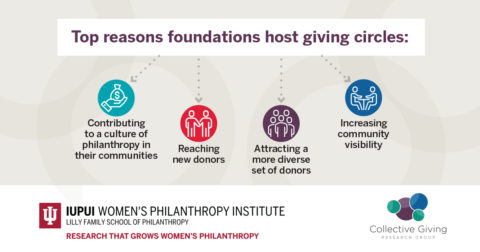What is Giving Compass?
We connect donors to learning resources and ways to support community-led solutions. Learn more about us.
Search our Guide to Good
Start searching for your way to change the world.
The number of giving circles in the United States has tripled over the past decade making it tough to ignore these collaborative powerhouses. Often incubated at large nonprofits, community foundations, or other intermediaries, giving circles provide a way for organizations to meet a strategic goal and bring donors together. So, how is it working?
 Based on a survey of host organizations, the Collective Giving Research Group found that giving circles offer benefits including: Contributing to a culture of philanthropy in the community (91 percent) and opportunities to reach out to new donors (85 percent). Challenges included the staff time required to manage the giving circle (82 percent) and different expectations between the giving circle and the host organization (52 percent).
Based on a survey of host organizations, the Collective Giving Research Group found that giving circles offer benefits including: Contributing to a culture of philanthropy in the community (91 percent) and opportunities to reach out to new donors (85 percent). Challenges included the staff time required to manage the giving circle (82 percent) and different expectations between the giving circle and the host organization (52 percent).
Against this backdrop, the Women’s Philanthropy Institute set out to learn about the relationship between one host organization and one giving circle in its network.
The Community Foundation for Northeast Florida (CFNEF) has hosted a giving circle since 2001 when the Women’s Giving Alliance (WGA) formed. At the time, now-CFNEF president Nina Waters had just joined the community foundation and both have “come of age” together. Waters recently shared her thoughts with us.
For CFNEF, the ROI from hosting giving circles -- it also home to the Beaches Community Fund and the LGBTQ Community Fund -- includes expansion of the leadership pipeline, encouraging more strategic philanthropy, nurturing diversity among donors with different perspectives, raising money from new donors, and strengthening the community. The Women’s Giving Alliance has allocated more than $6 million to the community since 2001.
“When women are inspired to engage philanthropically in a strategic way, all ways of engagement are strengthened and our community benefits,” said Waters, who is a WGA member. “We have seen over and over again the ripple effects of members learning about the multiple ways to engage philanthropically. They carry these nuggets to the other organizations they support.”
In addition to growing its leadership pool -- for instance, WGA members chair CFNEF’s governance, program & initiative and program related investment committees -- Waters says hosting WGA has created opportunities for strategic philanthropy expansion and the inclusion of diverse voices across the organization.
“With 490 members in 2018, WGA has women of all backgrounds,” Waters said. “We have members from throughout our five-county region and they help to inform not only the grants that WGA makes but also the broader grantmaking of the foundation.”
Waters offers a few suggestions to those considering hosting a giving circle (or three or four).
- Clearly state the purpose of starting/hosting a circle and the value proposition for both entities.
- Develop channels for open communication and education between the two entities.
- Create documents outlining the responsibilities of both groups that will clarify, shape, and nurture the relationship.
As more community foundations, intermediaries, national membership organizations, and others across the sector explore the benefits and opportunities of hosting giving circles, we hope the growing body of research on this movement and stories like CFNEF’s will encourage others to collaborate.
Categories:
- North America
- Women's Philanthropy
- Nonprofit Trends